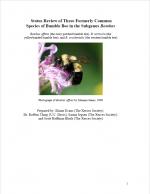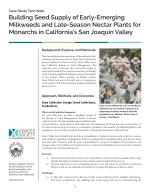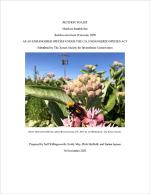As a science-based organization, the Xerces Society produces dozens of publications annually, all of which employ the best available research to guide effective conservation efforts. Our publications range from guidelines for land managers, to brochures offering overviews of key concepts related to invertebrate conservation, from books about supporting pollinators in farmland, to region-specific plant lists. We hope that whatever you are seeking—whether it's guidance on making a home or community garden pollinator-friendly, advice on developing a local pesticide reduction strategy, or detailed information on restoring habitat—you will find it here!
Find Publications
Use the search functions to sort by publication type (books, guidelines, fact sheets, etc.), location, and/or subject (agriculture, gardens, pollinators, pesticides, etc.).
Bombus affinis (the rusty patched bumble bee), B. terricola (the yellow-banded bumble bee), and B. occidentalis (the western bumble bee).
Assessing the status of Bombus affinis (the rusty patched bumble bee), B. terricola (the yellow-banded bumble bee), and B. occidentalis (the western bumble bee).
Handbook for Supporting Pollinators through Roadside Maintenance and Landscape Design
The best management practices provide concrete steps that can be taken by any roadside management agency to improve roadside vegetation for pollinators. The BMPs cover management of existing habitat, including ways to modify the use of mowing and herbicides to enhance roadsides, and methods to incorporate native plants and pollinator habitat into the design of new roadsides.
These best management practices are intended as a starting point for State DOTs looking to make roadsides more pollinator-friendly. This report is organized around the key findings of the literature review and the interview report
Managing Roadsides for Bees and Butterflies
These guidelines provide a concise overview of the conservation potential of roadside habitat and offer practical information on how to maximize the value of these areas for pollinators while meeting basic traffic safety requirements.
For financial, health, and cultural reasons, serious declines in pollinator populations are causing global alarm. Many electric power companies are concerned about the decline in pollinators and would like to understand more about pollinator science, conservation opportunities, and associated costs and risks. Through management of large real estate assets, there is ecological potential to enhance pollinator habitat through well-designed, ecologically meaningful, and cost-effective actions on property that power companies manage. This technical brief provides an overview of pollinators, considerations for power companies, and an introduction to conservation strategies.
Wild monarch butterfly populations have declined by an estimated 90% in the past two decades, due to habitat loss primarily in the Midwestern U.S., where these migratory butterflies spend the summer months. Monarch butterflies are routinely purchased from commercial growers for release at weddings, funerals, and other celebrations, and to raise in classrooms and exhibits for educational purposes. Out of concern for monarch conservation, some private citizens are also rearing hundreds to thousands of monarchs in backyard operations for release into the wild.
A Regional Stakeholders Report
Pollinator Conservation in the Portland Metro Area: A Regional Stakeholders Report summarizes the primary themes of that stakeholder meeting and identifies recommendations that conserve this essential ecological and economic resource.
A Regional Stakeholders Report
Pollinator Conservation in Minnesota and Wisconsin: A Regional Stakeholders Report summarizes the primary themes of that stakeholder meeting and identifies recommendations that conserve this essential ecological and economic resource.
Fall 2014
An update of the Xerces Society's monarch conservation efforts to date.






